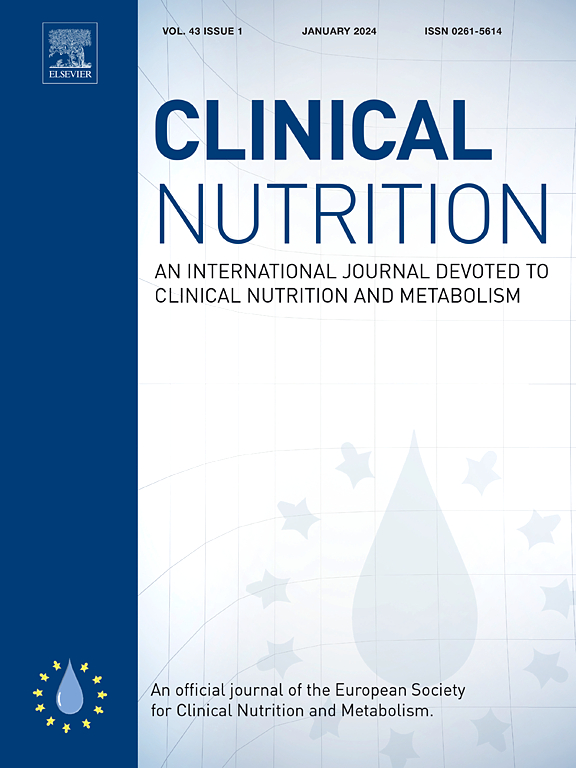克罗恩病合并短肠综合征患者接受家庭外肠营养治疗的临床结果与其他病因的短肠综合征患者相当
IF 6.6
2区 医学
Q1 NUTRITION & DIETETICS
引用次数: 0
摘要
背景,目的短肠综合征(SBS)和慢性肠衰竭患者需要家庭肠外营养(PN)支持。SBS的主要病因仍然是克罗恩病(CD),与其他病因的SBS相比,该队列的并发症仍有待确定。因此,我们试图调查继发于CD的SBS患者与继发于其他病因的SBS患者是否有增加的并发症风险,以及两组之间的总死亡率是否存在差异。方法:这是一项使用加拿大家庭肠外营养登记处(HPN)的多中心前瞻性队列研究。两组比较:1)继发于CD的SBS (SBS-CD)和2)继发于其他病因的SBS (SBS- other)(包括创伤、手术并发症、血管事件、扭转和恶性肿瘤)。每位患者的临床资料包括:住院次数、与HPN相关的住院次数和与HPN相关的住院天数、每1000导尿管天线脓毒症发生率和死亡率。描述性统计以连续变量的中位数(四分位数范围)和适当的分类变量的频率(百分比)表示。组间比较对连续变量采用两样本t检验、泊松回归分析或Wilcoxon秩和检验,对分类变量采用卡方检验或Fisher精确检验。采用Kaplan-Meir曲线和多变量分析评估死亡率。p值为<;0.05。结果共纳入383例SBS合并肠衰竭患者:172例(45%)为SBS- cd, 211例(55%)为SBS- other;随访中位数分别为4(2,6)年和2(2,4)年(p = 0.027)。两组在基线时具有可比性,除了年龄更小、小肠长度更短和免疫抑制药物使用率更高(39%对7%,p <;0.001)。SBS- CD组和SBS- other组的住院次数、住院天数和每1000个导管天的线败血症相似(p >;所有主要结局均为0.05)。两组间死亡率相似(SBS- CD组31例(26.72%),SBS- Other组37例(29.84%),p = 0.6676)。Kaplan-Meir曲线没有显示组间死亡率的统计学差异,但对整个患者群体的多变量分析显示,年龄与死亡率有关。在亚组分析中,与未接受免疫调节治疗的患者相比,接受免疫抑制治疗的SBS- CD患者住院或脓毒症的风险并不更高(0.50对1.57 p = 0.0417)。结论:与其他原因的SBS患者相比,SBS患者的住院、中心静脉感染或死亡率没有增加。在乳糜泻中,接受免疫调节疗法的患者出现并发症的风险似乎没有增加。本文章由计算机程序翻译,如有差异,请以英文原文为准。
Clinical outcomes in Crohn's disease patients with short bowel syndrome on home parenteral nutrition are comparable to those with short bowel syndrome from other etiologies
Background & aims
Patients with short bowel syndrome (SBS) and chronic intestinal failure require home parenteral nutrition (PN) support. The main cause of SBS remains Crohn's disease (CD), and complications in this cohort versus SBS from other etiologies remains to be determined. We therefore sought to investigate whether patients with SBS secondary to CD versus SBS secondary to other etiologies, have increased risk of complications and whether there is a difference in overall mortality between groups.
Methods
This is a multicentre prospective cohort study using the Canadian Home Parenteral Nutrition (HPN) Registry. Two groups were compared: 1) SBS secondary to CD (SBS-CD) vs. 2) SBS- secondary to other etiologies (SBS-Other) (including trauma, surgical complication, vascular event, volvulus and malignancy). Clinical data for each patient included: number of hospitalizations, number of hospitalizations related to HPN and number of hospitalization days related to HPN, incidence of line sepsis per 1000 catheter days and mortality. Descriptive statistics are presented as median (interquartile range) for continuous variables and as frequency (percentage) for categorical variables as appropriate. Comparison between groups were performed using a 2-sample t-test,Poisson regression analysis or Wilcoxon rank sum test for continuous variables and Chi-square or Fisher exact tests when appropriate for categorical variables. Kaplan-Meir curve and multivariate analysis was performed to assess mortality. Statistical significance is set at a p-value <0.05.
Results
The study included 383 patients with SBS and intestinal failure: 172 (45 %) SBS-CD and 211 (55 %) SBS-Other; followed for median of 4 (2, 6) years and 2 (2, 4) years respectively (p = 0.027). The groups were comparable at baseline except for younger age, shorter small bowel length and medications with higher use of immunosuppressant therapy (39 % vs. 7 %, p < 0.001) in those with CD. The number of hospitalizations, hospitalization days, and line sepsis per 1000 catheter days were similar amongst the SBS- CD and SBS-Other (p > 0.05 across all primary outcomes). Mortality events were also similar between groups (31 patients (26.72 %) in SBS CD group vs. 37 patients (29.84 %) in SBS- Other group, p = 0.6676). The Kaplan-Meir curve did not show a statistical difference in mortality between groups but a multivariate analysis of the entire patient population showed that age was associated with mortality. In subgroup analysis, patients with SBS- CD taking immunosuppressant therapy were not at higher risk of hospitalizations or line sepsis compared to those not on immunomodulating therapies (0.50 versus 1.57 p = 0.0417).
Conclusion
Individuals with SBS CD do not have increased risk of hospitalizations, central line infections or mortality compared to those with SBS from other causes. In CD, those on immunomodulating therapies do not appear to be at increased risk of complications.
求助全文
通过发布文献求助,成功后即可免费获取论文全文。
去求助
来源期刊

Clinical nutrition
医学-营养学
CiteScore
14.10
自引率
6.30%
发文量
356
审稿时长
28 days
期刊介绍:
Clinical Nutrition, the official journal of ESPEN, The European Society for Clinical Nutrition and Metabolism, is an international journal providing essential scientific information on nutritional and metabolic care and the relationship between nutrition and disease both in the setting of basic science and clinical practice. Published bi-monthly, each issue combines original articles and reviews providing an invaluable reference for any specialist concerned with these fields.
 求助内容:
求助内容: 应助结果提醒方式:
应助结果提醒方式:


